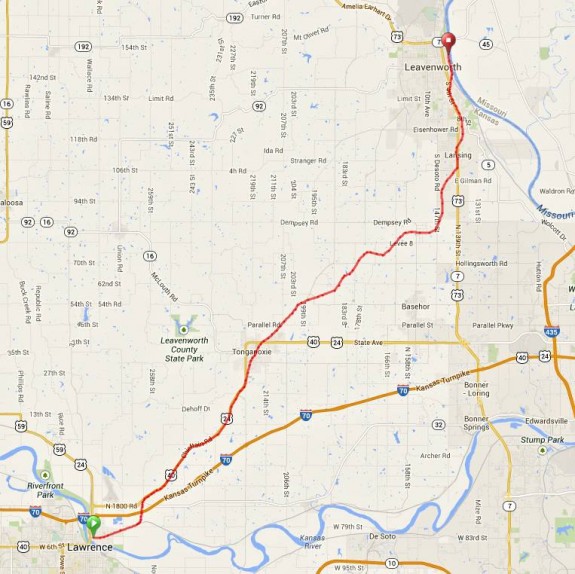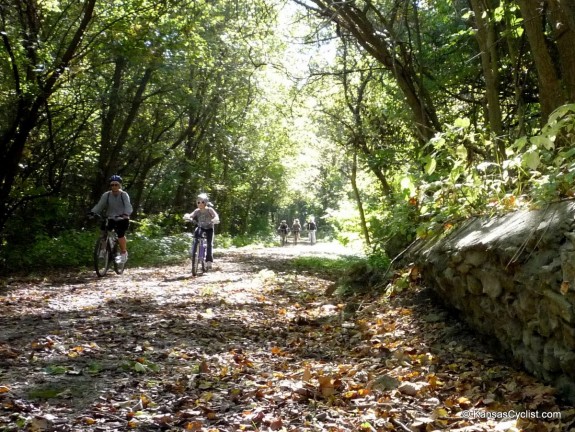In the late 1970s, Kansas rail-trail pioneers envisioned a route between Leavenworth and Lawrence, on an abandoned Union Pacific Railroad line. It was to be known as the “O-Keet-Sha Trail”, and would have been the first rails-to-trails conversion in Kansas. Sadly, it was not meant to be, but it laid the groundwork for today’s growing rail-trail network.
“O-Keet-Sha” is the Kansas Indian word for “stranger” (for Stranger Creek, the most substantial waterway along the route).
Perhaps the name was fitting. The idea for converting the old railroad right-of-way to a public trail was “strange” at the time. The concept was embraced by many people, but a few adjoining landowners and public officials reacted with fear, misinformation, and outright hostility, and ultimately obstructed the effort.
Here’s a rough map of the route:
(For a better, more detailed, map of the route, here’s a 1903 Leavenworth County Plat Map and a 1902 Douglas County Plat Map. Today, looking at satellite imagery, the old right-of-way can barely be discerned, having fallen to agriculture in a few places, but also to suburban housing developments.)
The View From 1978
There seems to have been a good deal of positive public sentiment in favor of the trail idea. On May 2, 1978, an editorial from the Lawrence Journal-World seemed to sum up the proposal rather sensibly:
Like the steam locomotives of past decades, time and the railroads have passed by the 30 miles of branch line between Lawrence and Leavenworth, through Tonganoxie. Now the unused rail line’s fate stands at a crossroads. Will it be parceled out to adjoining landowners along the right-of-way, or will it be converted — somehow — into a smooth-surfaced path for bicyclists and hikers?
The question has proved controversial. Landowners say their deeds entitle them to the easement once it’s formally abandoned. They say a bikepath would give vandals easy access to their homes and farms. On the other side, supporters of the bikeway point to successful bikeways fashioned from abandoned railbeds in other states, and they note the large public interest here and elsewhere in cycling and other active forms of recreation.
It may be that only the courts can settle some of the complicated aspects involved. But of the larger issue, there is little question: That railbed shouldn’t be lost to some type of public use. It is potentially a valuable asset. With similar paths rare — the Tonganoxie trail would be the first in Kansas — surely it would prove attractive to many local residents and might draw others from surrounding areas who would welcome use of the facility, and the opportunity to enjoy the constant beauty and relative seclusion of the winding trail. The possibility exists that the level, graded path to Leavenworth could connect with others along the Missouri and Kansas rivers, forming a loop that could become a genuine tourist attraction.
Weighed against those possibilities, the landowners’ case isn’t strong. Levees along the rivers already provide similar access for potential vandals, but few such crimes are reported. After all, Kansas has thousands of miles of rural roads, plenty to accommodate any potential criminals. If the line is abandoned piecemeal, the likely result in a few years will be an overgrown embankment in most places interrupted here and there by the odd house or overgrown weed patch. It would seem there are plenty of places for them, but only one existing right-of-way that could be converted relatively easily into a useful public asset.
Exactly how to proceed from here isn’t known, partly because apparently, conversion of a rail line has never been attempted in Kansas. It will take hard work by state and local officials — and a little more vision from some of them — to get the task accomplished. The result, if it’s done right, will be something the area can be proud of.
Despite, public support for the project, the plan was subsequently rejected by Leavenworth County:
For the second time this year, the Leavenworth County Commission has denied a request for support of the proposed bikeway along an abandoned rail line between Lawrence and Leavenworth. The move left bikeway supporters still faced with opposition from landowners along the 30-mile-long rail easement and from the local governmental unit representing most of the area through which the proposed trail would run. But, a principal bikeway advocate said, the effort to create the first bike and nature trail in Kansas from an abandoned rail line is by no means dead.
The support of the Leavenworth County Commission has been considered important because the overwhelming percentage of the abandoned Union Pacific rail line runs through unincorporated areas of the county. A short section lies within Douglas County, and county commissioners here have indicated support of the project, as has the Lawrence-Douglas County Planning Commission.
But in March, after an initial appearance by the bikeway supporters, the Leavenworth County commissioners asked a Kansas Legislature committee to kill a bill for a proposed bikeway park. The bill wasn’t acted on.
This week, the response was similar. One commissioner, James Lewis, Leavenworth, said the county would have to fence a 31-mile strip along the right of way, with half the cost being met by the taxpayers and half by nearby landowners He estimated the cost at $220.000. In response. Mrs Hughes said there’s no reason to fence the line except near pastures. Surely, she said, bicyclists are in no more need of fencing than railroad trains are.
This letter to the editor was published in the Lawrence Journal-World on June 14, 1978:
Last month the proponents of the O-Keet-Sha Trail were pleased to note the editorial endorsement by the Journal-World of the proposed nature path/bicycle path from Lawrence to Leavenworth. We couldn’t agree more that the railbed shouldn’t be lost to some type of public use. The railbed is a valuable asset and we feel it should be converted for alternate transportation, conservation of the native prairie and wildflowers, educational and research purposes with the historical and conservation aspects as an added bonus.
It would seem to us that with all the positive points favoring the public good, all the citizens of Kansas and the surrounding communities should pressure their law-makers to take the necessary steps to cause bicycle paths to happen in Kansas. Our state is way behind — The Appalachian Trail is a 2,000-mile-long monument to cooperative endeavor that was put together in the 1920’s. Just because we’re 50 years behind times doesn’t mean we have to stay behind forever. The railbed is a “Vanishing Opportunity” — let’s encourage our law-makers and move into the 20th century of progress. (Mrs.) Harriet J Hughes, Secretary/Treasurer, O-Keet-Sha Trail Conservation Committee.
Another letter to the editor in the Lawrence Journal-World shows a bit of the attitude that trail proponents were up against. The letter argues that rail-banking is an “effort to take land from the rightful owners without due process of law. Okay, bike trail proponents, go ahead. Get the land appraised, pay the owner a fair price and establish your trail. I make one request, please: do it with your own money. I doubt I will ever use the trail and I’m up to my neck in taxes already. By the way, do you mind if I and my friends have a picnic in your front yard next Sunday?”
So, ultimately, at some point, trail supporters were subdued, and the right-of-way was lost, probably forever. What an incredible waste.
Lost The Battle, Won The War
It would take another generation before a large-scale rails-to-trails project was built in Kansas, the wonderful Prairie Spirit Trail.
The story of the O-Keet-Sha Trail may be a sad and disgraceful chapter in Kansas transportation history, but it began a discussion, a movement, a transformation, that still continues. Today, there are Rail-Trails all over the Sunflower State, and more miles are being added every year.
Today the Governor publicly praises the hard work of trail volunteers and presses for more trail development, the Kansas Department Wildlife Parks and Tourism enthusiastically gushes about Kansas rail-trails (Kansas hops aboard rail trail development as boost to tourism industry), and the state is now investing $2.4 Million in the Flint Hills Nature Trail.
You have to think that developments such as those would have been simple inconceivable in 1978.
But with persistence, attitudes do change. Most people of good conscience eventually come to realize the obvious: rail-trails are good for individual health, community well-being, and economic vitality.
And the O-Keet-Sha Trail is not entirely forgotten. In 2013, as Leavenworth County was distributing it’s very first countywide trails map (PDF), the topic of the lost trail came up at some of the public meetings where the map was presented. Cecilia Harry, economic development coordinator for Leavenworth County, lamented the missed opportunity: “The county could have built more connecting trails in the 1980s. At that time, through the Rails to Trails Conservancy, there was an opportunity for the county to have a more connective trails system when abandoned railways started being transformed into trails. But Leavenworth County Commissioners instead approved returning the railways to property owners.” Leavenworth County finally realizes it made a huge mistake; unfortunately that realization came 35 years too late.
So here’s to the pioneers who advocated for the O-Keet-Sha Trail. Thank you for your service. Your vision has prevailed.
(Not the O-Keet-Sha Trail! This is the Flint Hills Nature Trail.)
Post tags: Lawrence, Leavenworth, Rail Trail, Tonganoxie





Well, the important thing is that some rednecks got the 20 square yards of land rightfully stolen from the Indians back so they can do jumps with their ATVs. I’m they put it to good use.
Sean: Inflammatory comments like yours are not going to win any support for the cycling/hiking community.